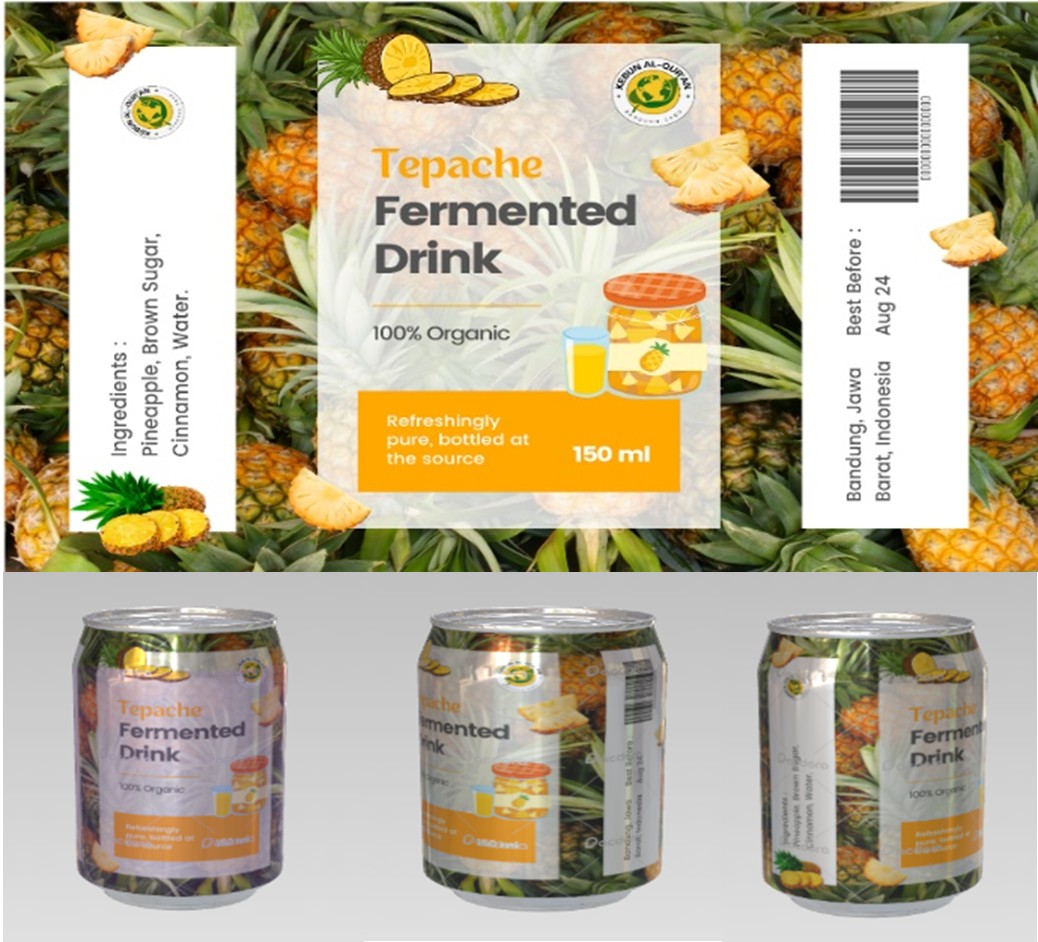Inovasi Pemasaran dan Pemanfaatan Potensi Profitabilitas pada Minuman Fermentasi Tepache
##plugins.themes.academic_pro.article.main##
Abstract
The food and beverage industry contributes significantly to the Indonesian economy. The fermented beverage market is growing due to consumer awareness of health. Recently, there has been a development in non-dairy fermented products, one example of a popular fermented drink is tepache. Tepache fermented drinks have the potential to become a business because in addition to utilizing waste, Indonesia also has the potential for local fruit. By applying production skills, packaging and storage technology, business management, and good marketing will support business potential. This community service program seeks to advocate marketing innovation and business opportunities. Because there are still obstacles, the product packaging currently used is less attractive to customers and there are still many prospective buyers who do not know the products and businesses of the Al-Qur'an garden due to the lack of information dissemination. The method used is Focus Group Discussion (FGD) for advocacy of marketing innovation and calculation of Production Cost for advocacy of business opportunities. The results obtained are packaging using cans that can maintain the quality and integrity of the product and informative packaging design to provide information effectively to customers and promotion through social media. In addition, tepache fermented drinks have promising business opportunities because the market is still open and the price range is in accordance with the health benefits offered by tepache fermented drinks.
##plugins.themes.academic_pro.article.details##

This work is licensed under a Creative Commons Attribution-NonCommercial 4.0 International License.
JURPIKAT (Jurnal Pengabdian Kepada Masyarakat) accepts manuscripts that have not been published elsewhere and are not under consideration for publication by other print or electronic media. Authors retain copyright and grant the journal right of first publication with the work simultaneously licensed under a Creative Commons BY-NC License that allows others to share the work with an acknowledgment of the work's authorship and initial publication in this journal.
Authors are able to enter into separate, additional contractual arrangements for the non-exclusive distribution of the journal's published version of the work (eg, post it to an institutional repository, in a journal or publish it in a book), with an acknowledgment of its initial publication in this journal.
License to Publish
The non-commercial use of the article will be governed by the Attribution-NonCommercial 4.0 International (CC BY-NC 4.0). The author hereby grants JURPIKAT (Jurnal Pengabdian Kepada Masyarakat) an exclusive publishing and distribution license in the manuscript include tables, illustrations or other material submitted for publication as part of the manuscript (the “Articleâ€) in print, electronic and all other media (whether now known or later developed), in any form, in all languages, throughout the world, for the full term of copyright, and the right to license others to do the same, effective when the article is accepted for publication. This license includes the right to enforce the rights granted hereunder against third parties.
References
Bahwita, U. S. (2022). Potensi Start Up Wirausaha Muda Ekonomi Kreatif Subsektor Kuliner Di Masa Pandemi Covid-19 di Kota Banda Aceh Ditinjau dari Perspektif Ekonomi Islam (Studi Pada Urban Teahouse Lampineung Banda Aceh). UIN Ar-Raniry.
Fauzani, E. (2021). Strategi Pemasaran dan Diversifikasi Produk Terhadap Volume Penjualan Buah Nanas (Studi Kasus pada Petani UMKM di Desa Tangkit Baru Kabupaten Muaro Jambi Provinsi Jambi). Jurnal Citra Ekonomi, 2(1), 100–111.
Gomes, I. A., Venâncio, A., Lima, J. P., & Freitas-Silva, O. (2021). Fruit-Based Non-Dairy Beverage: A New Approach for Probiotics. Advances in Biological Chemistry, 11(06), 302–330. https://doi.org/10.4236/abc.2021.116021
GrandViewResearch. (2019). Probiotic Drink Market Size, Share & Trends Analysis Report By Product (Dairy-based, Plant-based), By Distribution Channel (Offline, Online), By Region, And Segment Forecasts, 2020 - 2027.
Jumadi, O., Hala, Y., Sahribulan, & Kurnia, N. (2023). Pelatihan Pembuatan Minuman Fermentasi Tepache bagi Guru Biologi SMAN 1 Pamboang. Jurnal Pengabdian Masyarakat, 01(02), 156–161.
Khoiriyah, N. M., Hindarti, S., & Rianti, T. S. M. (2023). PREFERENSI MASYARAKAT TERHADAP KONSUMSI MINUMAN SEHAT DI KOTA MALANG. Jurnal Sosial Ekonomi Pertanian Dan Agribisnis, 1(03).
Ligenza, A., Jakubczyk, K., Kochman, J., & Janda, K. (2021). Health-promoting potential and microbial composition of fermented drink tepache. Medycyna Ogólna i Nauki o Zdrowiu, 27(3), 272–276. https://doi.org/10.26444/monz/138713
Marco, M. L., Sanders, M. E., Gänzle, M., Arrieta, M. C., Cotter, P. D., De Vuyst, L., Hill, C., Holzapfel, W., Lebeer, S., Merenstein, D., Reid, G., Wolfe, B. E., & Hutkins, R. (2021). The International Scientific Association for Probiotics and Prebiotics (ISAPP) consensus statement on fermented foods. Nature Reviews Gastroenterology and Hepatology, 18(3), 196–208. https://doi.org/10.1038/s41575-020-00390-5
Marsh, A. J., Hill, C., Ross, R. P., & Cotter, P. D. (2014). Fermented beverages with health-promoting potential: Past and future perspectives. Trends in Food Science & Technology, 38(2), 113–124.
Panghal, A., Janghu, S., Virkar, K., Gat, Y., Kumar, V., & Chhikara, N. (2018). Potential non-dairy probiotic products–A healthy approach. Food Bioscience, 21, 80–89. https://doi.org/https://doi.org/10.1016/j.fbio.2017.12.003
Pérez-Armendáriz, B., & Cardoso-Ugarte, G. A. (2020). Traditional fermented beverages in Mexico: Biotechnological, nutritional, and functional approaches. Food Research International, 136(March), 109307. https://doi.org/10.1016/j.foodres.2020.109307
Romero-Luna, H. E., Hernández-Sánchez, H., & Dávila-Ortiz, G. (2017). Traditional fermented beverages from Mexico as a potential probiotic source. Annals of Microbiology, 67(9), 577–586. https://doi.org/10.1007/s13213-017-1290-2
Šikić-Pogačar, M., Turk, D. M., & Fijan, S. (2022). Knowledge of fermentation and health benefits among general population in North-eastern Slovenia. BMC Public Health, 22(1), 1–11. https://doi.org/10.1186/s12889-022-14094-9
Widodo, S. (2019). Strategy of Strengthening Food and Beverage Industry in Indonesia. Journal of Economics and Behavioral Studies, 11(4 (J)), 102–110.

